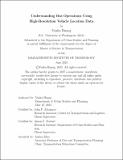Understanding Bus Operations Using High-Resolution Vehicle Location Data
Author(s)
Huang, Yuzhu
DownloadThesis PDF (37.89Mb)
Advisor
Attanucci, John P.
Stewart, Anson F.
Terms of use
Metadata
Show full item recordAbstract
High-resolution location data (heartbeat data) of transit fleet vehicles is a newfound data source for many transit agencies. On its surface, the heartbeat data can provide a wealth of information about all operational details of a recorded transit vehicle trip, from its location trajectory to its speed and acceleration profiles. In reality, the heartbeat data is often noisy and recorded at inconsistent frequencies, making it a challenging task for analysts to interpret the data as is. This thesis delves into the task of extracting useful operational information about bus vehicles from heartbeat data. In particular, the thesis focuses on three aspects of how heartbeat data can be used to enable operational analysis of transit routes.
First, a methodology is proposed to convert the raw, timestamped coordinate data into a continuous and smooth vehicle trajectory function of each bus trip. A case study using historical heartbeat data collected from a real-world bus trip is presented to showcase how a complete trajectory combined with the vehicle speed profile could allow for qualitative assessment of bus operations. Then, details are provided on how one can analyze the trajectories of multiple bus trips in aggregate to quantify the different types of delay encountered by bus vehicles, including stop dwell time, signal delay, crossing delay, and congestion delay. Case studies are presented to demonstrate how one can quantify each type of delay for a specific bus route or corridor served by multiple routes. Lastly, a thorough discussion is carried out about how one can conduct observational before-after studies using heartbeat data to draw conclusions about the effectiveness of transit improvement projects. A case study is provided to illustrate how one can evaluate the effectiveness of a stretch of bus-only lane by calculating the travel time savings due to the project.
The technical discussions presented in this thesis provide a solid foundation for conducting in-depth analysis of bus operations using heartbeat data. The methodologies will allow transit analysts to gain better insight into the performance of transit routes and corridors, thus allowing transit agencies to develop more targeted strategies for continuously improving transit services.
Date issued
2023-06Department
Massachusetts Institute of Technology. Department of Urban Studies and PlanningPublisher
Massachusetts Institute of Technology